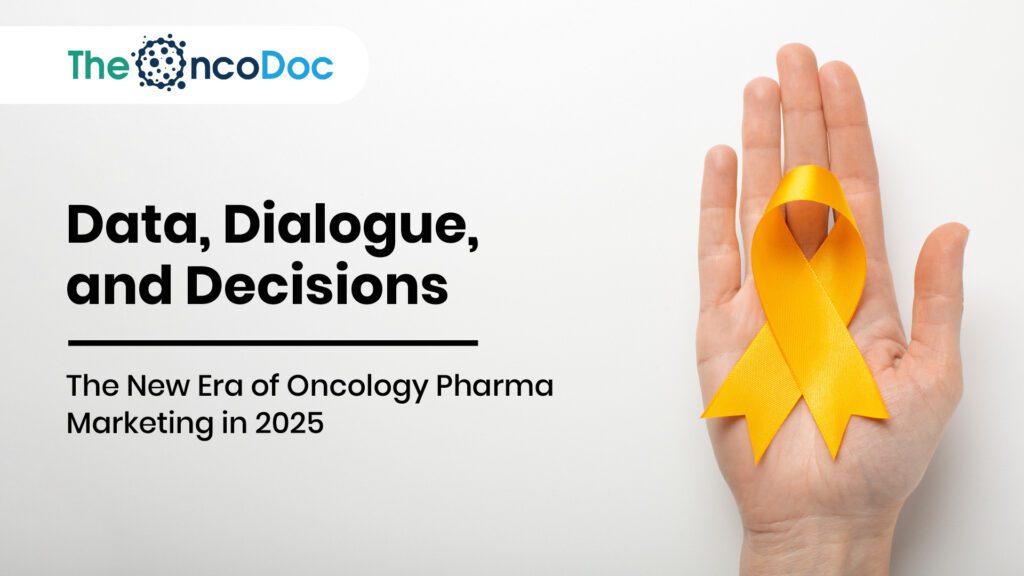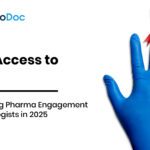Introduction: A Clinical Conversation, Not a Campaign
Pharmaceutical marketing in oncology has entered a seismic shift. As of 2025, the industry is no longer asking, “How do we promote a molecule?” but “How do we enable clinical clarity?” In a world driven by molecular subtypes, real-world evidence, and empowered care teams, oncologists demand more than messages. They seek mentorship, meaning, and measurable value.
Marketing in oncology is evolving from broad-spectrum messaging to highly calibrated engagement. This article unpacks how data-driven strategy, continuous peer dialogue, and evidence-based decision support define the new gold standard in pharma marketing to oncologists. Through 20 detailed insights and supported by charts, this guide aims to help medical marketers redefine impact in a competitive, patient-first marketplace.
1. The Rise of the Molecular Oncologist
Today’s oncologists are data integrators. They assess next-generation sequencing results, immune biomarker patterns, and real-world datasets in tandem with global and regional treatment guidelines to formulate tailored patient care plans. Marketing must now reflect this mindset by:
- Prioritizing evidence over emotion
- Delivering mutation-specific data
- Connecting trial endpoints with patient goals
Brand content that links mechanisms of action with real-world case scenarios becomes exponentially more valuable.
2. Decision-Centric Marketing Over Product-Centric Messaging
Rather than pushing drug features, pharma must assist oncologists in making better decisions. This includes:
- Presenting comparative data
- Highlighting inclusion/exclusion criteria for studies
- Offering actionable tools at the point-of-care
Marketing is now an enabler of clarity, not noise.
Case Example: A lung cancer campaign that featured visual algorithms comparing EGFR-TKIs across T790M-positive patients outperformed static brochures by 45% in retaining oncologist interest across three Asian markets.
3. Multidisciplinary Teams Demand Multi-Audience Communication
Oncology is no longer the domain of physicians alone. Today’s decisions are shaped by tumor boards, clinical pharmacists, oncology nurses, nutritionists, and care coordinators.
Pharma communication must be tiered in depth and tailored in format. Tumor boards might need data-heavy PDFs; nurses could benefit from visual symptom charts; while patients might require infographics or voice-based messaging in regional languages.
For instance, materials created for head and neck cancer nutrition guidance should include protein recipes co-branded with dietitians, while chemotoxicity management tools for nurses should be printable, visual, and scenario-based.
4. AI-Personalized Touchpoints Scale Credibility
Artificial intelligence is no longer a buzzword-it’s a core enabler of scalable personalization in pharma. AI-integrated customer relationship management (CRM) systems can now synthesize oncologist browsing behavior, EMR activity, and diagnostic tool usage to curate individual touchpoints. These touchpoints aren’t just promotional; they are educational, contextual, and clinically timed.
Example: If an oncologist recently searched PD-L1 expression data across metastatic non-small cell lung cancer (mNSCLC) cohorts, the AI backend can trigger a tailored email linking them to an animated MOA of PD-1 inhibitors, followed by a Q&A invite with a regional KOL. This precision enhances trust and ensures relevance.
Brands using AI-personalized outreach have observed a 31% reduction in content opt-outs and a 42% increase in targeted CME enrollments. Ultimately, AI drives quality at scale-connecting the right insight to the right clinician at the right time.
6. Omnichannel Is Not Optional
In 2025, omnichannel marketing is the industry standard-not a strategic differentiator. Oncologists expect to interact with pharma across multiple digital and physical environments without redundancy or message fatigue.
Successful omnichannel strategies ensure that a medical rep visit aligns with WhatsApp follow-ups, which are echoed in web portal logins and synced with email summaries. Data interconnectivity across platforms creates consistency and convenience.
One global oncology brand noticed a 55% uplift in brand recall when digital CME invites, sales calls, and follow-up summaries were tied to a common tumor-type theme over 6 weeks. Seamless omnichannel isn’t just about technology-it’s about unified messaging that respects oncologist time and attention.
7. CME as the New Cornerstone
Continuing Medical Education (CME) is no longer a side channel-it’s the centerpiece of impactful pharma engagement. CME offers an unbiased, non-promotional framework to deliver clinical value, engage with peer faculty, and drive behavioral change.
Today’s CME models include:
- Simulation-based tumor board games with point scoring
- Virtual clinical roundtables focused on guideline adaptations
- Interactive quiz modules tied to regional practice patterns
Metrics reveal CME formats with patient vignettes and outcome scoring drive up to 60% higher engagement. Pharma brands are also developing accredited modules in partnership with oncology societies, reinforcing scientific rigor and accessibility. The emphasis is clear: educate first, influence second.
9. KOLs are Catalysts, Not Celebrities
The days of KOLs as figureheads in dinner meetings are over. In the current landscape, key opinion leaders function as hands-on contributors, shaping educational content and guiding clinical discourse at both regional and institutional levels.
Modern KOL engagement involves:
- Co-developing podcasts focused on clinical dilemmas
- Moderating virtual tumor boards with real-world case reviews
- Hosting “fail case” debriefs to foster diagnostic learning
Trust rises when KOLs are seen as practicing peers-not polished spokespeople. Moreover, regional KOLs now have as much influence as national leaders, especially in Tier 2 and Tier 3 cities. By integrating their voices early in the content design phase, pharma elevates credibility and cultural fit.
10. Context is King in Communication
Even the most accurate content loses value if sent at the wrong time or to the wrong clinician. In 2025, contextual relevance drives both engagement and trust.
What does this look like? A hepatologist treating liver metastases receives weekly updates on cholangiocarcinoma trials, not generic GI oncology content. A breast oncologist practicing in Maharashtra sees campaign visuals in Marathi with local KOL commentary.
Trigger-based marketing models are crucial. They use referral patterns, EMR flags, or recent diagnostic queries to time outreach with precision. In turn, response rates and educational uptake rise significantly.
11. Investing in Vernacular and Regional Content
Language and localization are no longer afterthoughts. With over 20 languages spoken across India’s oncology care ecosystem, content that isn’t translated-and more importantly, culturally adapted-simply doesn’t connect.
Pharma brands now build state-specific content calendars. For example, a liver cancer awareness campaign launched in Telangana used Telugu-language patient animations and a Q&A with a Hyderabad-based KOL. Engagement rates were 3x higher than its Hindi-only version. Even urban oncologists prefer receiving follow-ups in regional dialects, especially when targeting family discussions.
Moreover, medical reps use voice-assisted mobile tools that automatically translate leave-behind brochures into the local language. This minimizes dependence on print and expands their reach in rural markets. In summary, localization builds trust, reduces friction, and elevates relevance.
12. The New Role of the Field Rep
Today’s medical representative in oncology is part educator, part consultant, and part digital navigator. Their influence depends less on charisma and more on content mastery, real-time access to data, and the ability to problem-solve clinical bottlenecks.
Let’s follow Ramesh, a rep in Chennai. Before visiting a GI oncologist, he reviews AI-assisted insights showing the doctor’s preference for neoadjuvant data. His visit includes:
- A real-world study summary comparing two regimens
- A QR code linking to an NCCN-guided dosing calculator
- An invitation to a city-wide CME co-hosted by a local teaching hospital
Post-meeting, he logs voice notes that instantly populate into CRM dashboards. The rep no longer sells a product-he’s a hub of real-time information and support.
Pharma firms investing in rep tech (tablets, mobile CRM, EMR-linked leave-behinds) report 35–40% increases in rep effectiveness scores and stronger post-meeting action rates.
13. The Value of Real-World Evidence (RWE)
RCTs remain the gold standard, but real-world evidence is now the cornerstone of personalization and practicality. Oncologists want to know how a therapy performs outside the tightly controlled trial environment.
Marketing strategy must include:
- Infographics summarizing population-level registries
- Tools for filtering RWE by region, age, or biomarker subgroup
- QR-based access to adverse event dashboards
For instance, a pharma company in Delhi co-published a white paper using claims and EMR data to compare the safety of its prostate cancer drug across North vs. South India. The campaign became a resource cited in tumor boards and led to a 23% increase in new scripts in underpenetrated zones.
RWE builds credibility. It converts data into confidence.
14. Video is the Preferred Medium for Many Oncologists
Doctors are short on time. A well-designed video delivers more value than a 4-page PDF. Video content works best when it is:
- Interactive and mobile-optimized
- Short (under 3 minutes)
- Visual (case charts, decision trees, animated pathways)
Effective formats include:
- Virtual patient journey walkthroughs
- “Day in clinic” case vignettes from regional oncologists
- MOA animation with quiz-based follow-up
A Mumbai-based study found that CME videos with embedded clinical polls had 62% completion rates-nearly double that of email-based reading content. Video is not a substitute for scientific depth but a delivery mechanism for faster, deeper recall.
15. Campaigns Must Include Outcome Metrics
Marketing in 2025 is data-first. Every campaign should come with a built-in feedback loop to measure:
- Clinical knowledge retention (via pre/post quiz)
- Intent-to-prescribe scores
- Patient engagement outcomes (like download or share rates)
Transparent results boost internal stakeholder buy-in and increase clinician trust. One pharma brand now publishes quarterly campaign scorecards with dashboard-style visuals summarizing reach, engagement, and script impact.
This metric-based approach helps marketers refine their future content strategy and builds internal alignment across sales, medical, and regulatory teams.
16. Digital Tools Must Solve Clinical Problems
Oncology HCPs no longer have patience for digital tools that are either gimmicky or detached from practice. Apps, bots, portals, or calculators must save time or improve decision-making.
Effective tools include:
- Drug-access simulators by insurance tier and geography
- Dosing calculators synced to patient weight or renal score
- Toxicity triage tools for chemotherapy side-effect prediction
Example: An immunotherapy brand launched a WhatsApp bot that offered immune-related adverse event (irAE) management guidelines in 6 languages. Over 18,000 oncologists and nurses used the tool in its first 90 days.
Solutions-not software-are what oncologists value.
18. Human-Centered Messaging for Caregivers and Families
Cancer care is communal. Caregivers influence medication adherence, diet, appointment scheduling, and overall emotional wellbeing.
Brands that equip caregivers with:
- Simple side-effect management leaflets
- Emotional resilience tips
- Financial navigation toolkits
… find stronger satisfaction scores, better adherence metrics, and enhanced brand recall.
Pharma messaging should include caregiver modules with QR links to vernacular resources. Some leading firms even train patient counselors in call centers to explain treatment options in regional languages
19. Sustainability and Access Are Now Communication Pillars
Physicians increasingly evaluate pharma brands based on sustainability and access initiatives. These include:
- Recyclable drug packaging
- Cold chain optimizations
- Local partnerships for affordability programs
An anti-EGFR brand partnered with state governments to co-fund a biosimilar rollout, cutting patient cost by 30%. The communication campaign emphasized sustainability, affordability, and accessibility-resonating powerfully with both physicians and public hospitals.
Ethical messaging enhances brand perception and fosters institutional trust.
20. Trust is the Only Sustainable Differentiator
Amid algorithm-driven marketing and competitive pipelines, trust remains the ultimate differentiator. Brands must build it through:
- Transparent data sharing
- Consistent educational delivery
- Fair and ethical promotion
Trust is reinforced when reps follow up not with repetition, but with responsiveness-tailored data, CME invites, and meaningful collaboration. In 2025, trust drives script loyalty, trial enrollment, and advisory participation.
Marketing ends where trust begins.
Conclusion: From Campaigns to Clinical Companionship
2025 isn’t just a digital age. It’s a deeply human one.
Pharma marketing must now mean something to the practicing oncologist-beyond product promotion. The winners will be those who shift from selling to serving, from reach to relevance, and from communication to contribution.
Marketing in oncology has matured. It’s now a clinical conversation guided by data, dialogue, and shared decision-making.
The Oncodoc team is a group of passionate healthcare and marketing professionals dedicated to delivering accurate, engaging, and impactful content. With expertise across medical research, digital strategy, and clinical communication, the team focuses on empowering healthcare professionals and patients alike. Through evidence-based insights and innovative storytelling, Hidoc aims to bridge the gap between medicine and digital engagement, promoting wellness and informed decision-making.



